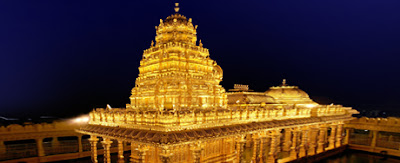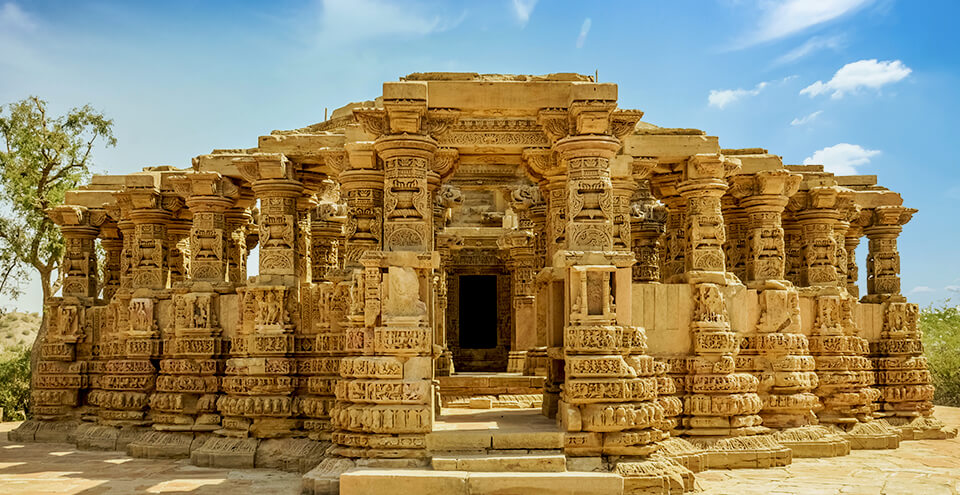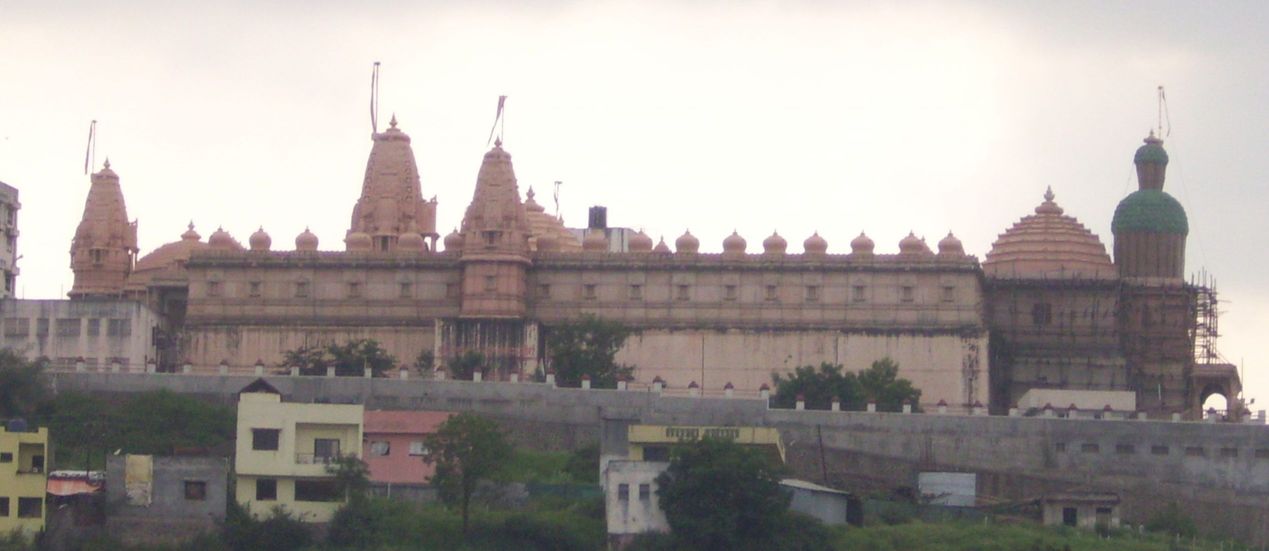आद्यन्तरहिते देवि आद्यशक्तिमहेश्वरि ।
योगजे योगसम्भूते महालक्ष्मि नमोऽस्तु ते ॥
One of the biggest Hindu shrines in southern India, the Sri Puram Golden Temple a grand golden temple built by a spiritual organization in Tamil Nadu at an approximate cost of US$160 million (Rs 600 crore), the consecration (kumbhabhishekam) was performed on August 24, 2007, presence of over 30,000 devotees.
The Mahalakshmi temple, located on a sprawling 100 acres of land at Sripuram, near Vellore, about 125 km from Chennai, has been constructed by Vellore-based Sri Narayani Peetam, headed by spiritual leader Sri Sakthi Amma. The Sripuram Lakshmi Narayani temple covering 5000 square feet is full of gold everywhere, all weighing 1500 kilograms at a cost of Rs. 350 Cr.
This Temple is to have the direct aspect of Lord Venkatachalapathy in Tirupathi. Hence, it was named Tirumalaikodi, in early days. Its construction began in 2000 and was completed in a short span of 7 years at a cost of Rs.300 crores (Rs.3 bil).Designed in the shape of sri chakra, it's unique feature is that the interior and exterior of Vimanam and Ardha Mandapam have been laid with gold sheets and plates.
Twelve layers of gold foils have been pasted on copper sheets embossed with the designs of Gods and fixed on the walls. This has already become highly popular and too crowded on weekends and will take several hours to complete the Dharshan during weekends.
"The Taj Mahal was built as an expression of love for a single person but the Sri Puram Golden Temple stands for unconditional love for the entire humanity," says Amma, 31, who also goes by the name of Shakti Siddha.
"We know it is also the sign of the universal goddess – Lakshmi," says William, who gives only one name and says he is of Canadian origin. The steps that lead to the innermost section are laid with polished black and grey granite from the neighboring South Arcot and Dharmapuri districts. The grey stone called "Paradiso" because of its wavy patterns of violet with the color of iron. And this too has been used in large quantities.
The temple with gold blanket, has perplexing work done by artisans having some expertise in temple symbolization utilizing gold. Each and every point of interest was physically made, including changing over the gold lumps into gold foils and afterward mounting the foils on copper. Gold foil from 9 layers to 0 layers has been mounted on the scratched copper plates. Each and every subtle element in the temple craftsmanship has essentialness from the vedas.
The religious focus of Sripuram, acclaimed brilliant temple is placed among the little green mountains in a zone called Malaikodi at Vellore city in Tamil Nadu state, India. It is found at the south a piece of Vellore city, at the spot of Tirumalaikodi.
The noteworthiness aspects of Sripuram are temple of Mahalakshmi or temple of Lakshmi Narayan who is Ardha Mandapam and Vimanam is covered with unadulterated gold including both inside and in addition outer surface.
"If we had built a hospital, factory, educational institution or a business, it would have ended up serving a small community. But now, Amma’s temple will sow the seeds of goodness in the hearts of everyone who visits here," Amma, clad in ochre robes, says in Tamil.
The temple, covering 55,000 sq ft area, has intricate carvings and sculptures in gold. Except the walking path, the entire structure has been covered with gold and copper.
This would be more grandeur than the any temple covered in gold across World, mutt sources said. About 400 goldsmiths and coppersmiths, including craftsmen from Tirumala-Tirupati Devasthanams, have completed the architectural marvel in gold in six years. More than one and one-half ton of pure gold was glitter and gleam under the sun, Devotees hail the temple as "one of the wonders of the world," and say that it is the only temple covered fully with gold.
According to official sources, the gold bars were purchased through RBI in "a transparent manner. " First the coppersmiths set to work creating a copper base on the temple structure with engravings and etchings before the gold, beaten into nine layers of foils, was draped around it. The sanctum sanctorum will hold the Deity of Mahalakshmi made of stone granite, but covered with gold kavacham (adornments).
"The Sripuram or Spiritual Park is Amma’s dedication to the world and mankind," said P. Murali, a trustee of the Peetam. The Sripuram Golden Temple complex inside the Sripuram spiritual park is situated at the foot of a small range of green hills at Thirumalaikodi (or simply Malaikodi) village, 8 km from Vellore in Tamil Nadu, India.
It is 120 km from Tirupati, 145 km from Chennai, 160 km from Puducherry and 200 km from Bengaluru.The maha kumbhabhishekam or consecration of the temple and its chief deity, Sri Lakshmi Narayani, was held on 24 August 2007, and devotees from all religions and backgrounds are welcome to visit. This temple is gilded with 1500 kg of pure gold.
The salient feature of 'Sripuram' is the Lakshmi Narayani temple whose Vimanam and Ardha Mandapam is covered with pure gold, housing the deity Sri Lakshmi Narayani (female consort of Vishnu Narayana). The temple is located on 100 acres of land and has been constructed by the Vellore-based charitable trust, Sri Narayani Peedam, headed by its spiritual leader Sri Sakthi Amma also known as 'Narayani Amma'.
The temple with its gold (1500 kg) covering, has intricate work done by artisans specializing in temple art using gold. Every single detail was manually created, including converting the gold bars into gold foils and then mounting the foils on copper. Gold foil from 9 layers to 10 layers has been mounted on the etched copper plates. Every single detail in the temple art has significance from the vedas.
Sripuram's design features a star-shaped path (Sri chakra), positioned in the middle of the lush green landscape, with a length of over 1.8 km. As one walks along this 'starpath' to reach the temple in the middle, one can also read various spiritual messages -- such as the gift of the human birth itself, and the value of spirituality -- along the way.
Surrounded by mountains and lush and scenic beauty, the temple, entirely conceived and designed by Amma, would be open to people of all religions. "The temple is Amma’s gift to mankind," the sources said. "When one enters the Sripuram, their focus is just on the magnificent temple.
But when they leave, they cannot do so without taking some messages and gaining some wisdom," according to a booklet detailing the ‘services’ rendered by the Peetam. "In this quagmire of materialism, Sripuram rises as an inspiration to man to find the divinity wit hin him," adds a brochure.
Murali said arrangements were being made to hire personnel to throw a security cover around the temple. "But the gold sheets have been laid out in such a manner that it would cost more to rip it off than purchase the gold," said a top Vellore district official.
Location
The Sri Lakshmi Narayani Temple located in ‘Sripuram’ (spiritual town) in Thirumalaikkodi, about seven km from here, was consecrated by Sri Sakthi Amma, head of the Sri Narayani Peedam, Thirumalaikkodi, on Friday. It is spread something like 100 sections of land of area, fabricated by Vellore’s Sri Narayani-Peedam lead by religious Guru Sakthi Amma.
Brilliant temple has confused statues, made by several master gold decorators; those have specialization in temple enrichment. the outer surface a piece of gold temple is secured with gold plates and sheets, with made considered to have aggregate expense of something like 300 crore ( 65 million US $).
The aggregate gold was utilized within this temple is around 1,500 kilograms which is the greatest sum even in whole world. The lighting arrangement of the gold temple is orchestrated to highlight the temple and even night, the temple sparkles. On 24, August 2007, the development of the temple was finished. The outer surface pathway of this temple is formed like a star that is 1.8 km of compass and its all dividers are embellished with the profound teachings of heavenly Guru Sakthi Amma.
Sripuram outline speaks to a star-molded way (Sri chakra), situated amidst the rich green scene, with a length of in excess of 1.8 km. One need to stroll along the star way to achieve the temple in the center, which is laid by messages from Sri Sakthi Amma and from diverse religions and otherworldly pioneers.
Unique structure
It is a unique temple whose ‘Vimanam’ and ‘Ardha Mandapam’ have been coated with gold both in the interior and exterior. Twelve layers of gold foils have been pasted on copper sheets embossed with the designs of Gods and fixed on the walls. One-and-a-half tonnes of gold has gone into the design of the Sri Lakshmi Narayani Temple, which has been built at a cost of Rs.300 crore.
100-acre site
According to Sri Sakthi Amma, the decision to have the temple coated with gold is only to attract visitors and enable them to get wisdom through the messages of the Vedas, which they will have to read before reaching the temple located on sprawling a 100 acre-site. The temple has been designed in such a way that visitors can reach the golden temple only after going through a star-shaped pathway, which has the messages from the Vedas on both sides.





















































